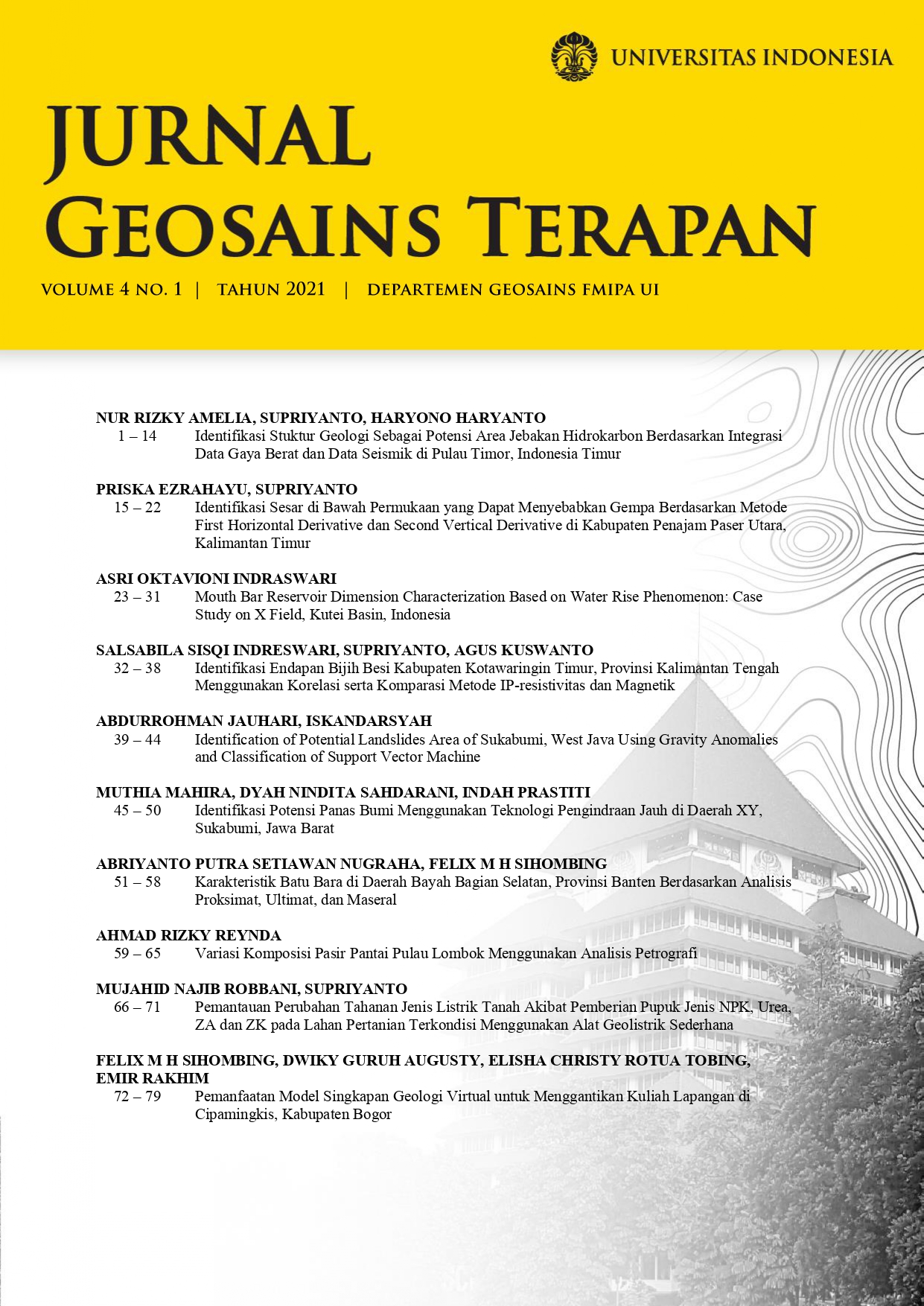Mouth Bar Reservoir Dimension Characterization Based on Water Rise Phenomenon
Case Study on X Field, Kutei Basin, Indonesia
Kata Kunci:
Mouth Bar Reservoir, Sequence Stratigraphy, Water RiseAbstrak
In X field, Kutei Basin, Indonesia, there are two hydrocarbon volume values known: Initial Gas in Place (IGIP), which is calculated based on predicted geomodel, and CGIP (Connected Gas in Place), which is an actual dynamic volume calculated from current production data. The discrepancy between IGIP (Initial Gas In Place) and CGIP (Connected Gas In Place) in the X field reaches 21%, with IGIP has more volume than CGIP. This discrepancy shows that the current geomodel gives over-optimistic values. To resolve this discrepancy between IGIP and CGIP, several parameters used in the current X geomodel, from which IGIP comes (e.g. mouth bar dimension, water rise discount limit, and net pay bar limit), need to be reviewed. There are two types of reservoir models in the X field: channel and mouth bar. This study only examined the mouth bar reservoir model since the the mouth bar reservoirs contributes 60% to the total IGIP. In the current geomodel, an 800 m pay bar limit is applied. Discount limit of 1000 m radius within water rise well is also applied to net pay. These numbers are hypothetical; thus, this study is carried out to check the connectivity and limit of the mouth bar reservoirs using well log correlation supported by pressure trend analysis. The study is focused on the X field at the interval of Stratigraphic Unit (SU) 4. This specific location and interval were chosen based on its high numbers of water rise occurrences. The methodology of this study includes well correlation using sequence stratigraphy concept, water rise analysis by finding the depletion source for reservoir with water rise, and detail sand to sand correlation supported by pressure data to define bar limit...
Referensi
Ainsworth, R.B., 2005. Sequence stratigraphic-based analysis of reservoir connectivity: influence of depositional architecture – a case study from a marginal marine depositional setting. Pet. Geosci. 11, 257 LP – 276. https://doi.org/10.1144/1354-079304-638
Doust, H., Noble, R., 2008. Petroleum systems of Indonesia. Mar. Pet. Geol. - MAR Pet. GEOL 25, 103–129. https://doi.org/10.1016/j.marpetgeo.2007.05.007
Dunham, J.B., Brown, T.J., Lin, R., Redhead, R.B., Schwing, H.F., Shirley, S.H., 2001. Transport and concentration of gas-and oil-prone kerogens into deep water sediments of the Kutei Basin, East Kalimantan, Indonesia.
Galloway, W.E., 1975. Process framework for describing the morphologic and stratigraphic evolution of deltaic depositional systems.
Hyne, N.J. (1995). Sequence stratigraphy: a new look at old rocks. In Sequence Stratigraphy of the Mid-Continent (pp. 5-17).
Moss, S., Chambers, J., 1999. Tertiary facies architecture in the Kutai Basin, Kalimantan, Indonesia. J. Asian Earth Sci. - J ASIAN EARTH SCI 17, 157–181. https://doi.org/10.1016/S0743-9547(98)00035-X
Moss, S.J., Chambers, J., Cloke, I., Satria, D., Ali, J.R., Baker, S., Milsom, J., Carter, A., 1997. New observations on the sedimentary and tectonic evolution of the Tertiary Kutai Basin, East Kalimantan. Geol. Soc. London, Spec. Publ. 126, 395–416.
Saller, A., Lin, R., Dunham, J., 2006. Leaves in turbidite sands: The main source of oil and gas in the deep-water Kutei Basin, Indonesia. Am. Assoc. Pet. Geol. Bull. 90, 1585–1608.
Siemers, C.T., Chambers, J.L.C., Allen, G.P., 1994. Field Seminar on the Sedimentology and Sequence Stratigraphy of Modern and Ancient Fluvial, Deltaic and Shelf Deposits. Mahakam delta/Kutei Basin fluvial/deltaic depositional systems, East Kalimantan, Indonesia. Am. Assoc. Pet. Geol. Geoservices.
Van Wagoner, J.C., Mitchum, R.M., Campion, K.M., Rahmanian, V.D., 1990. Siliciclastic sequence stratigraphy in well logs, cores, and outcrops: concepts for high-resolution correlation of time and facies.
Unduhan
Diterbitkan
Cara Mengutip
Lisensi
Hak Cipta (c) 2021 Jurnal Geosains Terapan

Artikel ini berlisensi Creative Commons Attribution-NonCommercial-NoDerivatives 4.0 International License.


